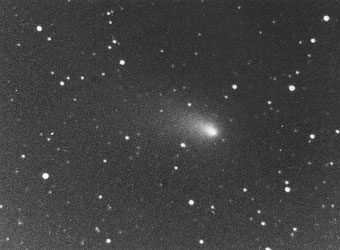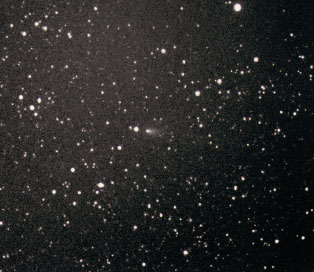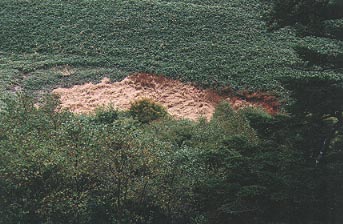
| Return |
| • October 30 While observing in the dome, I saw a meteor streaming from Orion to Auriga (to the northeast) over a long distance. It was just at 4 minutes past 4 in the morning. The color of the meteor was an orange and the magnitude was -3. It lasted for 7 to 8 seconds. It was the first fireball I had seen in some weeks. Deep into Autumn, the day break has become late. I searched the eastern sky for about half an hour starting around 4.30. It was on October 28, 1923 when Comet Horvath-Yamasaki (later renamed Krommelin) was discovered in Leo. It was near ? Leo close to the ecliptic and at 10th magnitude when discovered. Comets had frequently appeared in this area and I searched very carefully. I have been using Nikon's 12cm binoculars for 30 years and the lenses' transparency has deteriorated. In spite of that, I can still see 10th-magnitude comets. I don't look for faint comets but hope for a sudden encounter with comets brighter than 9th magnitude. Look at this impressive appearance of C/2000 WM1(LINEAR), which has increased its size. |
 C/2000 WM1 (LINEAR) 6-minute exposure from 4:17 am on October 30, 2001 Geisei Observatory 60cm reflector Tsutomu Seki |
| • October 18 C/2000 WM1 has been brightening gradually. It was faintly visible in the 20cm refractor at 11.9 magnitude. In photographs by the 60cm telescope an impressive tail is seen. Even small aperture telescopes can capture the comet easily. The photograph below was taken by Mr. Masamitsu Nakamura in Shizuoka Prefecture using a 10cm f/4.0 camera with a 30-second exposure (with CCD). In spite of a small image, the coma and tail are captured clearly. In January it will be at 6-7 magnitude and will show a magnificent tail. Will it become a great binocular comet? I searched the eastern sky from 4 o'clock in the morning. Forty years ago today, I was in the middle of the excitement of the discovery of Comet Seki (1961f). I hurried to Tokyo to appear on NHK (Japanese national broadcaster) TV. It was the year that changed my life. At 5 in the morning β Leo emerged in faint twilight. Comet Seki had been discovered immediately west of this star. Although the sky conditions had deteriorated, M65 and M66 were faintly visible. I think it's impossible to discover faint comets using 20x 12cm binoculars, but am hopeful for finding comets brighter than 9th magnitude. In the well brightened sky Venus appeared. It was a refreshing morning after completing my search. |
 C/2000 WM1(LINEAR) 00:12 October 14 PENTAX 10cm f:400mm Masamitu Nakamura |
| • October 7 The regular event "the evening for starwatching" was held at Choja of Niyodomura Village. As the weather forecast for the day predicted worsening weather ending up in rain later, I brought a lot of slides of astronomical objects just in case. Contrary to the forecast, the stars began to appear 30 minutes into the event and in the end it turned out to be a night for "starwatching under clear skies." The event was geared toward the audience of about 100 parents and children in the village. I set up the 9 cm comet seeker that had discovered a number of comets. The visitors enjoyed the starry sky very much. The following morning, after staying overnight at an old inn where I made it a rule to stay whenever I came to this villate, I drove along the mountain roads at an elevation of more than 1500 meters. The roads run through the central mountain ranges of Shikoku Island represented by Ishizuchiyama and Kamegamori mountains. I also saw a series of mountains, such as Sasagamine, Kanpusan, and others, after which I had recently named the minor planets. I happened upon Kannarashi-ike Pond. I heard that the pond had appeared suddenly with a tremendously loud sound. It looked like a meteor crater to me. It is slightly longer in the east-west direction and used to hold some water. Yoshinogawa River, the greatest river of Shikoku, originates in this area. |
 Kannarashi Pond (The photo taken on October 8) |
| • October 1 It is the mid-autumn full moon tonight. (This is a significant full moon in the Japanese calendar. ) Usually around this time of year this beautiful moon is often disturbed by capricious clouds, but tonight it is surprisingly clear. The almost-perfectly-round, golden moon is floating over Mount Hitusan, which is silhouetted against the moon-lit sky. There are more stars seen tonight than in an ordinary moonless sky! The air must be quite clear and transparent. Someone is performing the first movement of Beethoven' Moonlight Sonata in adagio. Where do these tercets on the piano come from? Is it just my imagination? Or is it music from a concert at the famous Katsurahama Beach traveling over the mountains in the south. As time passes, the moon has become brighter turning the whole sky gold. A flock of geese flew away to the north in a beautiful mountain-shaped formation. |
Copyright (C) 2001 Tsutomu Seki.